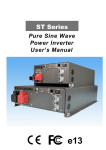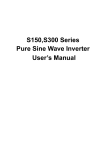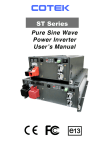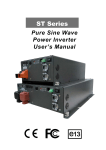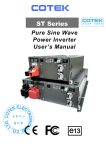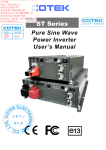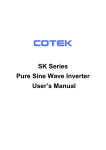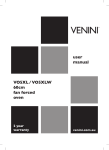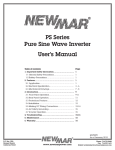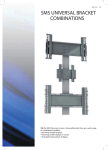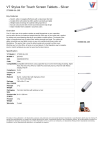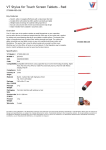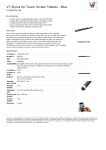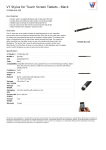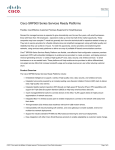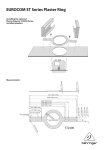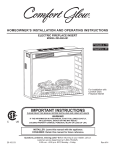Download Matrix Software e13 User's Manual
Transcript
ST Series Pure Sine Wave Power Inverter User’s Manual e13 Contents 1. Important Safety Instructions……………………………………………………………………. 2 1-1 General safety precautions…………………………………………………………………… 2 1-2 Precautions when working with Batteries…………………………………………………… 2 2. Functional Characteristics.………………………………………………………………………. 3 2-1 General Information…………………………………………………………………………. 3 2-2 Application……………………………………………………………………………………. 3 2-3 Features………………………………………………………………………………………. 3 2-4 Electrical Performance………………………………………………………………………. 5 2-5 Mechanical drawings………………………………………………………………………... 6 3. Installation…………………………………………………………………………………………… 7 3-1 Where to install………………………………………………………………………………. 7 3-2 Hard-wire Installation………………………………………………………………………... 8 3-3 DC Wiring Connections………….…………………………………………………………. 9 4. Introduction…………………………………………………………………………………………. 11 4-1 Inverter Operation……………………………………………………………………………... 11 4-2 Front Panel Operation.……………………………………………………………………….. 12 4-3 Protection Features….……………………………………………………………………….. 16 4-4 Rear Panel Operation.……………………………………………………………………….. 17 5 Information………………………………………………………………………………………….. 17 5-1 Troubleshooting…………………….……………………………….…………………………. 17 5-2 Maintenance………………………………………………………..………………………….. 18 5-3 Warranty………………………………………………………………………………………... 18 6. Appendices………………………………………………………………………………………….. 19 6-1 FCC (Class A) Declaration of Conformity………………………………………………… 19 6-2 CE (LVD EN60950) Declaration of Conformity…………………………………………... 20 6-3 e-mark (e13) Declaration of Conformity………………………………………………….. 21 6-4 UL (UL458) NOTICE OF COMPLETION….……………………………………………... 22 ©Copyright :This manual is the copyright of COTEK Electronic lnd. Co., Ltd. And may not be reproduced or copiedwithout the express permission of the owner. 1 1. Important Safety Instructions WARNING ! Before using the Inverter, read and save the safety instructions. 1-1. General Safety Precautions 1-1-1. Do not expose the Inverter to rain, snow, spray, bilge or dust. To reduce risk of hazard, do not cover or obstruct the ventilation openings. Do not install the Inverter in a zero-clearance compartment. Overheating may result. 1-1-2. To avoid a risk of fire and electronic shock. Make sure that existing wiring is in good electrical condition; and that wire size is not undersized. Do not operate the Inverter with damaged or substandard wiring. 1-1-3. This equipment contains components which can produce arcs or sparks. To prevent fire or explosion do not install in compartments containing batteries or flammable materials or in locations which require ignition protected equipment. This includes any space containing gasoline-powered machinery, fuel tanks, or joints, fittings, or other connection between components of the fuel system. 1-2. Precautions When Working with Batteries 1-2-1. If battery acid contacts skin or clothing, wash immediately with soap and water. If acid enters eye, immediately flood eye with running cold water for at least 20 minutes and get medical attention immediately. 1-2-2. Never smoke or allow a spark or flame in vicinity of battery or engine. 1-2-3. Do not drop a metal tool on the battery. The resulting spark or short-circuit on the battery of other electrical part may cause an explosion. 1-2-4. Remove personal metal items such as rings, bracelets, necklaces, and watches when working with a lead-acid battery. A lead-acid battery produces a short-circuit current high enough to weld a ring or the like to metal, causing a severe burn. 2 2. Functional Characteristics 2-1. General Information ST-series completes with stand –alone power inverter with AC transfer switch and is suitable for RV, Marin and Emergency appliances. When utility AC power cutoff, the transfer relay is de-energized and the load is automatically transferred to the Inverter output. Once the AC utility is restored, the relay is energized and the load is automatically reconnected to AC utility. This power inverter series is a member of the most advanced line of mobile AC power systems available. To get the most out of the power inverter, it must be installed and used properly. Please read the instructions in this manual before installation and operation this model. 2-2. Application 2-2-1 Power tools–circular saws, drills, grinders, sanders, buffers, weed and hedge trimmers, air compressors. 2-2-2. Office equipment – computers, printers, monitors, facsimile machines, scanners. 2-2-3. Household items – vacuum cleaners, fans, fluorescent and incandescent lights, shavers, sewing machines. 2-2-4. Kitchen appliances – coffee makers, blenders, ice markers, toasters. 2-2-5 Industrial equipment – metal halide lamp, high – pressure sodium lamp. 2-2-6. Home entertainment electronics – television, VCRs, video games, stereos, musical instruments, satellite equipment. 2-3. Features 2-3-1. Pure sine wave output (THD < 3%) to operate higher-end electronic Equipments. 2-3-2. Output frequency 2-3-3. Built in 16A or 25A rating transfer switch. 50 / 60Hz switch selectable 3 2-3-4. Speed up transfer time and synchronized operation with the AC source at all times that allows the transfer to be interruption-free for sensitive equipments. 2-3-5. Built in advance microprocessor to make friendly interface with user. 2-3-6. Low power “ Power Saving Mode “ to conserve energy 2-3-7. Capable of driving highly reactive & capacitive loads at start moment. 2-3-8. Hardwire AC connection model option. 2-3-9. Loading controlled cooling fan. 2-3-10. Smart remote controller. 2-3-11. 3 LED indicators with tri-color display all operation status. 2-3-12. High efficiency 88 ~ 93%. 2-3-13. Protection: Input over voltage and Input low voltage protection. Low battery alarm Over temperature protection. Over load protection Short Circuit protection Reverse polarity protection. AC circuit breaker (6Amp to 30Amp) 4 2-4. Electrical Performance Specification Model No. Item ST1000-112 ST1000-124 ST1000-148 ST1000-212 ST1000-224 ST1000-248 Continuous Output Power 1000W Maximum Output Power (3Min.) 1150W Surge Rating 2000W Input Voltage 12V Output Voltage 24V 48V 12V 100 / 110 / 120V ± 3% Frequency 24V 48V 220 / 230 / 240V ± 3% 50 / 60Hz +/- 0.05% (Switch Selectable) Output Waveform Pure Sine Wave (THD < 3%) Efficiency (full load) 88% 91% 92% 90% 93% 94% No Load Current Draw 1.43A 0.75A 0.38A 1.25A 0.65A 0.35A Stand-By Current Draw 0.25A 10.5-15 VDC 0.15A 21.0-30 VDC 0.09A 42.0-60 VDC 0.25A 10.5-15 VDC 0.15A 21.0-30 VDC 0.09A 42.0-60 VDC Input Voltage Regulation Input Level Indicator Red / Orange / Green LED Load Level Indicator Failure Indicator Red LED Protection Overload, Short Circuit, Reverse Polarity (Fuse),Over Temperature Over/Under Input Voltage, AC Input Circuit Breaker Circuit Breaker 12 Amp Remote Control Unit 6 Amp CR6 / CR7 / CR8 Optional Synchronous AC transfer YES Transfer switch 16 Amp Transfer Time 4~8 msec. Safety Meet UL458 EMC Meet EN60950-1 EN55022: 1997 EN55024: 1997 EN61000-3-2: 1998 EN61000-3-3: 1995 FCC Class A Operating Temperature Range Storage Temperature Range e-Mark 022967 0 - 40 -30 to 70 Cooling Loading controlled cooling fan Dimensions 373(L)*236(W)*115(H) mm / 14.7(L)*9.29(W)*4.53(H) Inch Weight 6.2 kgs. / 13.6 Lbs. Note: The specifications are subject to change without notice. 5 2-4. Electrical Performance Specification Model No. Item ST1500-112 ST1500-124 ST1500-148 ST1500-212 ST1500-224 ST1500-248 Continuous Output Power 1500W Maximum Output Power (3Min.) 1725W Surge Rating 3000W Input Voltage 12V Output Voltage 24V 48V 12V 100 / 110 / 120V ± 3% Frequency 24V 48V 220 / 230 / 240V ± 3% 50 / 60Hz +/- 0.05% (Switch Selectable) Output Waveform Pure Sine Wave (THD < 3%) Efficiency (full load) 88% 91% 92% 90% 93% 94% No Load Current Draw 1.45A 0.75A 0.40A 1.40A 0.70A 0.40A Stand-By Current Draw 0.28A 10.5-15 VDC 0.15A 21.0-30 VDC 0.09A 42.0-60 VDC 0.28A 10.5-15 VDC 0.15A 21.0-30 VDC 0.09A 42.0-60 VDC Input Voltage Regulation Input Level Indicator Red / Orange / Green LED Load Level Indicator Failure Indicator Red LED Protection Overload, Short Circuit, Reverse Polarity (Fuse),Over Temperature Over/Under Input Voltage, AC Input Circuit Breaker Circuit Breaker 16 Amp Remote Control Unit 10 Amp CR6 / CR7 / CR8 Synchronous AC transfer Transfer switch Optional YES 25 Amp Transfer Time 16 Amp 4~8 msec. Safety Meet UL458 EMC Meet EN60950-1 EN55022: 1997 EN55024: 1997 EN61000-3-2: 1998 EN61000-3-3: 1995 FCC Class A Operating Temperature Range Storage Temperature Range Meet e-Mark 0 - 40 -30 to 70 Cooling Loading controlled cooling fan Dimensions 403(L)*236(W)*115(H) mm / 15.9(L)*9.29(W)*4.53(H) Inch Weight 7.0 kgs. / 15.4 Lbs. Note: The specifications are subject to change without notice. 6 2-4. Electrical Performance Specification Model No. Item ST2000-112 ST2000-124 ST2000-148 ST2000-212 ST2000-224 ST2000-248 Continuous Output Power 2000W Maximum Output Power (3Min.) 2300W Surge Rating 4000W Input Voltage 12V Output Voltage 24V 48V 12V 100 / 110 / 120V ± 3% Frequency 24V 48V 220 / 230 / 240V ± 3% 50 / 60Hz +/- 0.05% (Switch Selectable) Output Waveform Pure Sine Wave (THD < 3%) Efficiency (full load) 88% 91% 92% 90% 93% 94% No Load Current Draw 2.6A 1.50A 0.70A 2.3A 1.1A 0.65A Stand-By Current Draw 0.60A 10.5-15 VDC 0.30A 21.0-30 VDC 0.2A 42.0-60 VDC 0.60A 10.5-15 VDC 0.3A 21.0-30 VDC 0.15A 42.0-60 VDC Input Voltage Regulation Input Level Indicator Red / Orange / Green LED Load Level Indicator Failure Indicator Red LED Protection Overload, Short Circuit, Reverse Polarity (Fuse),Over Temperature Over/Under Input Voltage, AC Input Circuit Breaker Circuit Breaker 25 Amp Remote Control Unit 12 Amp CR6 / CR7 / CR8 Synchronous AC transfer Transfer switch Optional YES 25 Amp Transfer Time 16 Amp 4~8 msec. Safety Certification Meet UL458 EMC Meet EN60950-1 EN55022: 1997 EN55024: 1997 EN61000-3-2: 1998 EN61000-3-3: 1995 FCC Class A Operating Temperature Range Storage Temperature Range Meet e-Mark 0 - 40 -30 to 70 Cooling Loading controlled cooling fan Dimensions 433(L)*332(W)*115(H) mm / 17(L)*13(W)*4.53(H) Inch Weight 11.2 kgs. / 24.6 Lbs. Note: The specifications are subject to change without notice. 7 2-4. Electrical Performance Specification Model No. Item ST2500-112 ST2500-124 ST2500-148 ST2500-212 ST2500-224 ST2500-248 Continuous Output Power 2500W Maximum Output Power (3Min.) 2875W Surge Rating 5000W Input Voltage 12V Output Voltage 24V 48V 12V 100 / 110 / 120V ± 3% Frequency 24V 48V 220 / 230 / 240V ± 3% 50 / 60Hz +/- 0.05% (Switch Selectable) Output Waveform Pure Sine Wave (THD < 3%) Efficiency (full load) 88% 91% 92% 90% 93% 94% No Load Current Draw 2.35A 1.3A 0.7A 2.4A 1.5A 0.65A Stand-By Current Draw 0.5A 10.5-15 VDC 0.35A 21.0-30 VDC 0.19A 42.0-60 VDC 0.6A 10.5-15 VDC 0.35A 21.0-30 VDC 0.19A 42.0-60 VDC Input Voltage Regulation Input Level Indicator Red / Orange / Green LED Load Level Indicator Failure Indicator Red LED Protection Overload, Short Circuit, Reverse Polarity (Fuse),Over Temperature Over/Under Input Voltage, AC Input Circuit Breaker Circuit Breaker 30 Amp Remote Control Unit 16 Amp CR6 / CR7 / CR8 Optional Synchronous AC transfer YES Transfer switch 25 Amp Transfer Time 4~8 msec. Safety Certification Meet UL458 EMC Meet EN60950-1 EN55022: 1997 EN55024: 1997 EN61000-3-2: 1998 EN61000-3-3: 1995 FCC Class A Operating Temperature Range Storage Temperature Range Meet e-Mark 0 - 40 -30 to 70 Cooling Loading controlled cooling fan Dimensions 463(L)*332(W)*115(H) mm / 18.2(L)*13(W)*4.53(H) Inch Weight 12 kgs. / 26.4 Lbs. Note: The specifications are subject to change without notice. 8 ST1000 373.00 [14.69] ST1500 403.00 [15.87] 2-5. Mechanical drawings AC INPUT POWER STATUS 0 BREAKER NEG(-) LOAD LEVEL I 0 S S S S 1 2 3 4 DC INPUT POWER INPUT LEVEL 1 REMOTE PORT ON-OFF-REMOTE POS(+) REVERSE POLARITY WILL DAMAGE UNIT 9 ST2000 433.00 [17.05] ST2500 463.00 [18.23] 2-5. Mechanical drawings AC INPUT POWER STATUS 0 WARNING: REVERSE POLARITY WILL DAMAGE UNIT DC INPUT POS(+) LOAD LEVEL I 0 S S S S 1 2 3 4 BREAKER POWER INPUT LEVEL 1 REMOTE PORT ON-OFF-REMOTE NEG(-) 10 3. Installation 3-1.Where to install The power inverter should be installed in a location that meets the following requirements: 3-1-1. Dry – Do not allow water to drip or splash on the inverter. 3-1-2. Cool – Ambient air temperature should be between 0 the cooler the better. and 40 , 3-1-3. Safety – Do not install batteries in compartment or other areas where flammable fumes existence such as fuel storage areas or engine compartments. 3-1-4. Ventilated – Allow at least one inch of clearance around the Inverter for air flow. Ensure the ventilation shafts on the rear and bottom of the unit are not obstructed. 3-1-5. Dust-free – Do not install the Inverter in a dusty environments where dust, wood particles or other filings/shavings are present. The dust can be pulled into the unit when the cooling fan is operation. 3-1-6. Close to batteries – Avoid excessive cable lengths but do not install the inverter in the same compartment as batteries. Use the recommended wire lengths and sizes (see section 4-3). Do not mount the inverter at the place where it is exposed to the gases produced by the battery. These gases are very corrosive and prolonged exposure will damage the inverter. WARNING! Shock Hazard. Before proceeding further, carefully check that the inverter is NOT connected to any batteries, and that all wiring is disconnected from any electrical sources . Do not connect the output terminals of the inverter to an incoming AC source. 11 3-2 Hard-wire Installation AC wiring connections: 3-2-1. The AC wiring compartment is located on the front panel of the ST series. Remove the AC wiring compartment cover to gain access to the AC terminal. WARNING! Before you connect AC wiring to the terminals of compartment cover, ensure to check the label in the compartment for correct connections. Wrong connection will damage the inverter. 12 3-2-2. Connect AC output and AC input wiring to the ST series terminals. Please take the following information as your reference. Wire length / gauge Terminal Wire color ST1000&ST1500 ST2000&ST2500 Line (L) AC OUTPUT Neutral (N) Black White Within 16 feet / AWG# Within 16 feet / AWG# Line (L) AC INPUT Neutral (N) Ground Brown 14~16 10 ~12 Blue 26~32 feet / AWG# 26~32 feet / AWG# Green / Yellow or Bare copper 12~14 8 ~10 3-2-3. Please double check and review all connections to ensure the wires are in correct terminals and the connections are tight. 3-2-4. Before connecting AC output and AC input terminals of the ST series, you can either use front compartment cover or a side hole to coil out. Both AC input and AC output are coiled out from the front compartment cover when in production. If you want to change the position, you should open the top cover first, and then switch the wire of the front compartment cover and the plastic cover of the side of top cover. AC INPUT POWER STATUS 0 S S S S 1 2 3 4 BREAKER NEG(-) LOAD LEVEL I 0 INPUT LEVEL 1 DC INPUT POWER REMOTE PORT ST1000 ST1500 ON-OFF-REMOTE POS(+) REVERSE POLARITY WILL DAMAGE UNIT 13 ST2000 ST2500 AC INPUT POWER STATUS 0 WARNING: REVERSE POLARITY WILL DAMAGE UNIT DC INPUT POS(+) LOAD LEVEL I 0 S S S S 1 2 3 4 BREAKER POWER INPUT LEVEL 1 REMOTE PORT ON-OFF-REMOTE NEG(-) 3-3 DC Wiring Connections Follow the instructions to connect the battery cables to DC input terminals of the Inverter. The cable should be as short as possible (less than 6 feet / 1.8 meters ideally) so that it can handle the required current in accordance with the electrical codes or regulations application. Inappropriate length of cables will deteriorate the inverter performance such as poor surge capability, frequent low-input voltage warnings, and shutdown. UVP warning occurs when DC voltage drops across the cables from the inverter to the batteries. The longer or narrower the cables, the more the voltage drop. Increasing your DC cable size will help improve the situation. The following recommended cables are for the best performance of the inverter. (Apply both 120V and 230V versions) 14 Model No Wire AWG Inline Fuse ST1000-112 / 212 #2 150 A ST1000-124 / 224 #4 80 A ST1000-148 / 248 #6 40 A ST1500-112 / 212 #2 200 A ST1500-124 / 224 #4 100 A ST1500-148 / 248 #6 50 A ST2000-112 / 212 # 2/0 250 A ST2000-124 / 224 # 1/0 125 A ST2000-148 / 248 #2 70A ST2500-112 / 212 # 4/0 400 A ST2500-124 / 224 # 2/0 200 A ST2500-148 / 248 # 1/0 100 A 3-3-1. Connect the cables to the power input terminals on the front panel of the inverter. The red terminal is positive (+) and black terminal is negative (-). Insert the cables into the terminals and tighten screw to clamp the wires securely. WARNING! Make sure all the DC connections are tight (torque to 9 – 10 ft-lbs, 11.7 – 13 Nm). Loose connections could result overheat in a potential hazard. WARNING! The installation of a fuse must be on positive cable. Failure to place a fuse on “+” cables running between the inverter and battery may cause damage to the inverter and will void warranty. Also, only use high quality copper wire and keep the cable length short which is a maximum of 3 - 6 feet. 15 AWG#2 - #6 ST-1000 ST-1500 NE G( -) PO S( +) INLINE FUSE 16 WASHER RING TERMINAL WASHER SPRING WASHER M8 NUT PVC WIRE RING TERMINAL M8 NUT SPRING WASHER Append: The holes on red/black plastic cover of DC input terminal are on top when in production. The user can change them to the bottom if necessary. PLASTIC COVER ST2000 ST2500 INLINE FUSE AC INPUT POWER STATUS 0 POS(+) LOAD LEVEL I 0 S S S S 1 2 3 4 BREAKER POWER INPUT LEVEL 1 WARNING: REVERSE POLARITY WILL DAMAGE UNIT DC INPUT REMOTE PORT ON-OFF-REMOTE NEG(-) 17 4. Introduction: 4-1.Inverter Operation Switch the power ON, then the power inverter is ready to supply AC power to the loads. Turn on the loads separately after the inverter is ON to prevent OVP status caused by the surge power. 4-1-1. Switch the power ON, then the buzzer will send out beep sound. At the moment, the inverter is doing self-diagnosis. Then the LED’s indicators will also show various colors. Finally, the buzzer will send out another beep, and the Input Level and Status LED indicators will turn green. Then the inverter will start to work. 4-1-2. Switch the power OFF, then the inverter stops and all the lights that are On will go Off. 4-1-3. Switch the power inverter and the test load ON, then the inverter will supply the power to the load. If you want to measure true RMS voltage output of the inverter, a meter such as FLUKE 45 BECKMAN 4410 or TRIPLETT 4200 must be used. 4-2. Front Panel Operation 4-2-1. Front view AC INPUT POWER STATUS 0 BREAKER NEG(-) LOAD LEVEL I 0 S S S S 1 2 3 4 DC INPUT POWER INPUT LEVEL 1 REMOTE PORT ON-OFF-REMOTE POS(+) REVERSE POLARITY WILL DAMAGE UNIT 18 AC INPUT POWER STATUS 0 WARNING: REVERSE POLARITY WILL DAMAGE UNIT DC INPUT POS(+) LOAD LEVEL I 0 S S S S 1 2 3 4 BREAKER POWER INPUT LEVEL 1 REMOTE PORT ON-OFF-REMOTE NEG(-) 4-2-2. Power ON / OFF / REMOTE (Main) switch: a. Before installing the inverter, you need to ensure the main switch is in the OFF position. b. Before using the remote unit, you need to ensure the main switch is in the REMOTE position. 4-2-3. AC input Circuit Breaker: The AC input circuit breaker protects the model from overload. When an overload condition exists, the circuit breaker stops to supply output AC grid power. To reset it, push the circuit breaker switch then the model will be back in normal operation. The source fault should be corrected before you reset it. 4-2-4. Remote Port: The ST Series Inverter is compatible with any of these remote controllers: CR-6, CR-7 or CR-8. 4-2-5. DC Input Terminals: Connect DC input terminals to 12V / 24V / 48V battery or other power sources. [ + ] represents positive, [ - ] represents negative. Reverse polarity connection can blow the internal fuse and may damage the inverter permanently. Model 12V 24V 48V DC Input Voltage Minimum Maximum 10.5V 15.0V 21.0V 30.0V 42.0V 60.0V 19 4-2-6. Chassis Ground: Connect the wire # 8 AWG to vehicle chassis. WARNING! Operating the inverter without a proper ground connection may cause electrical safety hazard. 4-2-7. DC Input Level Display Input Voltages LED Status DC 12V DC 24V DC 48V RED Blink (slow) 10.5~10.9 21.0~21.8 42.0~43.6 RED ORANGE GREEN ORANGE Blink 10.9~11.3 11.3~12.0 12.0~14.0 14.0~14.7 21.8~22.6 22.6~24.0 24.0~28.0 28.0~29.4 43.6~45.2 45.2~48.0 48.0~56.0 56.0~58.8 OVER RED BLINK 14.7q 29.4q 58.8q 4-2-8. AC Input Level Display Input Status LED Status AC Input ORANGE OFF GREEN ON 4-2-9. Load Level Display AC Loads (Watts) LED Status DARK GREEN ORANGE RED BLINKING RED ST1000 0 ~ 50W 50 ~ 330W 330 ~ 750W 750 ~ 960W Over 960W ST1500 0 ~ 75W 75 ~ 495W 495 ~ 1125W 1125 ~ 1450W Over 1450W ST2000 0 ~ 100W 100 ~ 660W 660 ~ 1500W 1500 ~ 1920W Over 1920W ST2500 0 ~ 125W 125 ~ 825W 825 ~ 1875W 1875 ~ 2390W Over 2390W 20 4-2-10. AC Frequency Selected by “S4” Dip Switch Frequency S4 50 HZ OFF 60 HZ ON 4-2-11. Status Display Power & Fault Status Green LED LED Signal Status Solid Power OK Slow Blink Power Saving Red LED LED Signal Status Fast Blink OVP Slow Blink UVP Intermittent Blink Solid OTP OLP 4-2-12. Power Saving Mode: Power Saving Mode is adjustable and set by the Dip Switches, S1, S2 and S3 on the front panel. Example: The load should be set above15W. If the load is below15W, the power saving mode will be activated. 21 ST1000 ST1500 ST2000 ST2500 S1 S2 S3 DISABLE DISABLE OFF OFF OFF 20W 40W ON OFF OFF 40W 80W OFF ON OFF 50W 100W ON ON OFF 60W 120W OFF OFF ON 80W 160W ON OFF ON 90W 180W OFF ON ON 110W 220W ON ON ON 4-3.Protections Features DC Input (VDC) Model Over Voltage Over Temperature Protection Under Under Voltage INTERIOR HEAT SINK Shut- Restart Voltage Shut- Restart Shut- Restart Shut- Restart down down down Alarm down 12V 15.3 14.2 11.0 10.5 12.5 24V 30.6 28.4 22.0 21.0 25.0 48V 61.2 56.8 44.0 42.0 50.0 70 45 90 60 22 4-4. Rear Panel Operation 4-4-1. Rear view 4-4-2. Fan Ventilation: Be sure to keep it a distance (at least 1 inch) form surrounding things. 5. Information 5-1. Troubleshooting WARNING Do not open or disassemble the ST series Inverter. Attempting to service the unit may cause the risk of electrical shock or fire. 23 Problems and Symptoms Possible Cause No AC Power “Output” STATUS illuminates the LED Solutions a. Power status light is blinking fast. Over input voltage. (OVP) Check input voltage Reduce input voltage. b. Power status light is Blinking slowly. Low input voltage. (UVP) Recharge battery. Check connections and cables. c. Power status light is blinking Intermittently. Thermal shutdown. (OTP) Improve ventilation. Make sure ventilation, shafts of the inverter are not obstructed. Lower ambient temperature. d. Power status light is glowed steadily. Short circuit. Wiring error. Over Loading (OLP) Check AC wiring for short circuit. Reduce load. 5-2. Maintenance Very little maintenance is required to keep your inverter operating properly. You should clean the exterior of the unit periodically with a damp cloth to prevent accumulation of dust and dirt. At the same time, tighten the screws on the DC input terminals. 5-3. Warranty We guarantee this product against defects in materials and workmanship for a period of 24 months from the date of purchase and will repair or replace any defective power inverters if you directly returned them to us with postage paid. Please note that Cotek is only responsible for ensuring our products are operational before delivering. This warranty will be considered void if the unit has been misused, altered, or accidentally damaged. Cotek is not liable for anything that occurs as a result of the user’s fault. 24 25


























